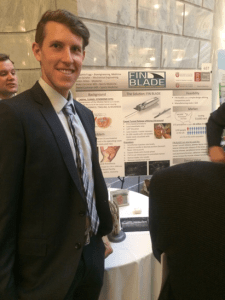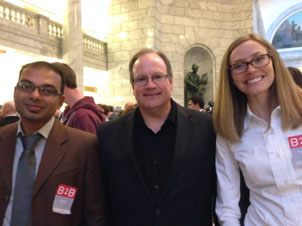By Austen Paulsen for BioLawToday.org.
This year, the University of Utah’s Center for Medical Innovation (CMI) hosted the 6th annual Bench to Bedside competition on Monday, April 4th. As patent law fellows for the CMI, Thomas Woodland, Dave Duncan and I worked with many of the competitors, explaining the process of obtaining patent protection on their new technologies and preparing and filing provisional patent applications. Of the thirty-three teams competing in this year’s competition, fifteen teams were able to file provisional applications through the CMI.
 Competition Night is an awesome opportunity to see the culmination of all the work the competitors put into their devices throughout the year. Most of the competitors don’t have completed prototypes until right before the competition so for the patent fellows, it was really cool to see a physical embodiment of the project we had helped to work with. The fact that the teams that receive patent advice from the patent fellows often perform exceptionally well on Competition Night makes this night all the more exciting. Of the eight patent applications that I prepared, UVAC, Wacian-Pleth Patch, Umbilikit, and Fin Blade all received cash prizes from Bench to Bedside.
Competition Night is an awesome opportunity to see the culmination of all the work the competitors put into their devices throughout the year. Most of the competitors don’t have completed prototypes until right before the competition so for the patent fellows, it was really cool to see a physical embodiment of the project we had helped to work with. The fact that the teams that receive patent advice from the patent fellows often perform exceptionally well on Competition Night makes this night all the more exciting. Of the eight patent applications that I prepared, UVAC, Wacian-Pleth Patch, Umbilikit, and Fin Blade all received cash prizes from Bench to Bedside.
Competition Night included speeches from several University and community leaders, including Dr. Vivian Lee, Dean of the University of Utah’s School of Medicine and CEO of University of Utah Health Care; Dr. John Langell, Executive Director of the Center for Medical Innovation; Troy D’Ambrosio, Executive Director of the Lassonde Entrepreneur Institute; and Scott Anderson, President and CEO of Zions Bank. All of these leaders were extremely impressed by this year’s competitors and expressed their enthusiasm for the Bench to Bedside program and the impact that it has on the community.
Bench to Bedside is a competition open to all University of Utah students in which teams compete to develop new medical devices and create start-up companies to market their products. This competition is multi-disciplinary and teams comprised mixes of students from the College of Medicine, David Eccles School of Business, and College of Engineering, among others. A variety of medical devices were featured at this year’s competition ranging from a video game to help veterans deal with post-traumatic stress disorder to minimally invasive device to aid surgeons in treating carpal tunnel release to a vacuum-assisted device to stop postpartum hemorrhaging. This year cash prizes of over $70,000 were awarded, including a grand prize of $15,000, two runner-up awards for $10,000, and $5,000 awards for best engineering, best business, most green and many more.
 I was fortunate enough to work as a patent fellow with the Center for Medical Innovation for two years. This experience has been very helpful for me; I have gained a lot of real-world experience, filing a total of eleven provisional applications as a fellow. I learned a lot about the process of creating new inventions by working with teams of inventors from across campus. The Bench to Bedside competition is a unique and invaluable experience for all those involved, it creates a community of entrepreneurship and has spawned twenty-seven companies that are currently working on commercializing their technologies.
I was fortunate enough to work as a patent fellow with the Center for Medical Innovation for two years. This experience has been very helpful for me; I have gained a lot of real-world experience, filing a total of eleven provisional applications as a fellow. I learned a lot about the process of creating new inventions by working with teams of inventors from across campus. The Bench to Bedside competition is a unique and invaluable experience for all those involved, it creates a community of entrepreneurship and has spawned twenty-seven companies that are currently working on commercializing their technologies.
For more information on the Bench to Bedside Competition, visit the Center of Medical Innovation’s website at: http://healthsciences.utah.edu/center-for-medical-innovation/students/bench-to-bedside.php
Austen is currently a third year law student at the University of Utah’s S.J. Quinney College of Law. Austen is a fellow for the Center for Medical Innovation as well as an intern for the Lassonde New Venture Development Program. Austen graduated from the University of Utah with a B.S. in Chemical Engineering and is planning on pursuing a career in intellectual property law. He is an avid mountain biker and races downhill mountain bikes competitively. Austen is also a snowboarder, runner, weight lifter and lover of all things outdoors.
